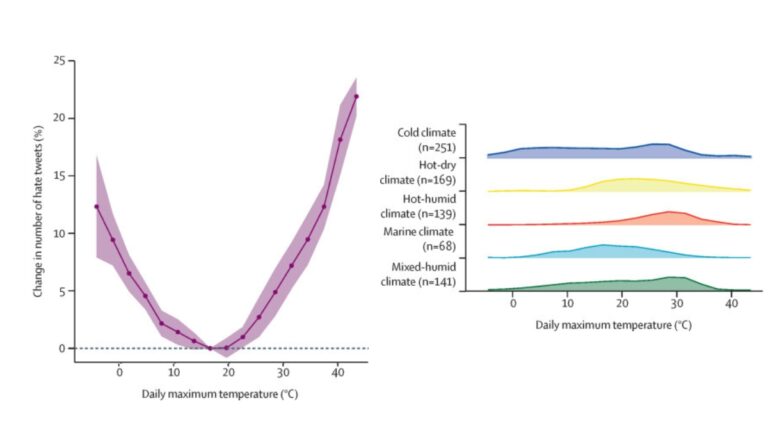Heated Tweets
A nation-wide study exploring the connection between aggression and temperature found that the prevalence of hate speech increased as temperatures became more extreme.

Read Time: 2 minutes
Published:
Extreme temperatures and interpersonal aggression are connected. Does this connection translate into the digital world?
For the 60% of the world population that uses the internet, experiencing hate speech online has become normal. Almost half of all Americans have experienced online harassment. Annika Stechemesser and colleagues explored if these aggressions might be associated with extreme temperatures.
The team identified 4 billion geo-located tweets containing hate speech originating from 773 cities across the U.S. They then looked at fluctuations in local temperatures. They tested whether the number of hate tweets increased during extreme temperatures.
As the left graph shows, the prevalence of hate tweets was lowest during moderate temperatures and increased as temperatures got hotter and colder. At 40 degrees Celsius (104 degrees Fahrenheit), changes in hate tweets increased by more than 20%. The graph on the right shows the number of hate tweets across cities with different climates.
The authors explain that people retain their anger and aggression longer during extreme temperatures, even after extreme temperatures have relented. They argue that this could mean that humans have a limit on how much we can adapt to changes in temperature.
Even the fastest climate mitigation strategies will not be able to curb extreme temperature effects swiftly. People will continue to experience hate speech, which can incite violence and lead to hate crimes, particularly towards marginalized groups, which in turn can result in physical health problems and elevated blood pressure.
Databyte via Annika Stechemesser, Anders Levermann, and Leonie Wenz, Temperature impacts on hate speech online: evidence from 4 billion geolocated tweets from the USA. The Lancet Planetary Health, 2022.



